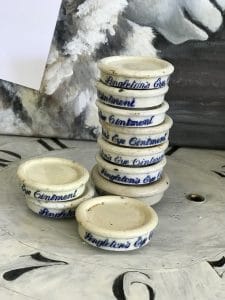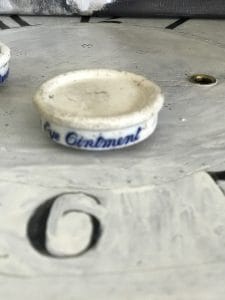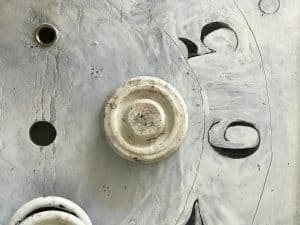This is a listing for one (1) Singleton’s Eye Ointment. Great little addition to your Antique Advertising collection. Don’t miss out. These sell out quickly! Interesting history below captured from several websites including (ointment pots.com)
HISTORY:
The earlier Singleton’s pedestals carried the name Singleton’s Golden Eye Ointment, thereafter the word “Golden” was dropped, probably around 1899.
Pot shapes changed over the following years with the “foot” reducing in height size. All the pedestals carry lettering in blue print and vary in width and height sizes.
The ointment itself was placed on top of the pedestal and covered with a wax paper seal to preserve the ointment. These were distributed by the producers in a cardboard box.
The distinctive short rounded pot was the packaging for an ointment introduced in the 1700s. The ointment was made from a recipe dating from the late 1590s and passed down through the Singleton family by marriage.
The Manufacture of Singletons Eye Ointment
The manufacture of the Singleton’s Eye Ointment has been carried on down to the present day in the same old house just mentioned.
A.D. 1779 to 1816
Thomas Singleton, who died November 29th, 1779, left the recipe, per his will, to his son, William Singleton. In 1799, during Williams Singleton’s proprietorship, he received a testimonial from the war office, signed by his royal highness, the Duke of York, bearing testimony to the great value of Singleton’s Eye Ointment, which had been ordered for use in the British Army while in Egypt, 1798 to 1800, during the campaign against Napoleon Bonaparte.
Large numbers of British soldiers whose eyes had been injured by the hot desert sand of Egypt were perfectly cured by its use.
William Singleton settled the right and recipe on his only child, his daughter Selina, on her marriage to Timothy Folgham.
Selina Folgham who died January 10th 1816, left the recipe, per her will, to her five children, to share and share alike.
It was about the year 1804 that the porcelain pedestal pots were first made expressly for Singleton’s Eye Ointments.
One of these pots was subsequently acquired by Sir E.W.Franks, K.C.B., for the Franks collection in the British museum.
A.D. 1816 to 1825
As the eldest child of this union, when William Singleton Folgham died, the recipe vested in the next eldest, viz. Selina, by virtue of an award by Robert Bowyer, Esq. (ordered by Lord Eldon), which was made an order in Chancery. William Singleton Folgham died July 26th, 1826 (vide the Singleton family tomb).
A.D. 1825 to 1874
In 1825, Selina Folgham, the holder of the recipe for Singleton’s Eye Ointment, married Mr Stephen Green, her one fifth share, thereof, being the subject of her marriage settlement.
She was the great grandaughter of Thomas Singleton, and at her death, on March 13th, 1831, the one fifth share became the property of Mr Stephen Green.
For a large consideration, she purchased the rights of the next two children, the fourth and fifth being wards in Chancery under a commission of lunacy.
An annuity for each one of them was arranged, and these annuities were paid until their death in the year 1879.
From the year 1848, Mr Stephen Green became the sole and entire proprietor of the recipe and emoluments thereof.
A.D. 1874 to present time ( circa 1930)
Mr Stephen Green died, aged 77, in 1874 and after remaining a short time in the hands of his niece, the recipe passed in 1877, per Mr Stephen Green’s will, to his grand-nephew and namesake Mr Stephen Green, now deceased. His personal representatives now hold the recipe and continue the manufacture of the old remedy.
(this info was taken from the Paul Barker’s ointment pot website on the internet and from the british museum.)
This pot was curated during my travels to England’s Antique Markets while visiting my daughter and her family in London.
The images attached are for the pot you will receive.
Most pots have some level of crazing , may have spots of discoloration, light hairline cracks and minor chips and fleabites that only add to its character and do not detract from its display value. These are expected due to age, use and let’s not forget they were often buried for decades before being dug up and rescued.
I offer substantial savings in shipping costs when multiple items are combined into one package. I work hard to find the most economical shipping options available by checking multiple discount carriers.
I will credit any over payment of postage charged to you after finding the best shipping option. I check both ParcelMonkey.com and Shipgooder.com for the most economical delivery to save you shipping dollars. These companies negotiate better rates with USPS, Fed Ex and UPS than individuals can on their own.
 ..
.. ..
..

There are no reviews yet.